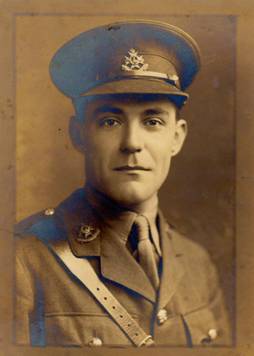
Lieutenant
CONWAY JOHN HART
16th (Service) Battalion (Chatsworth Rifles)
The Sherwood Foresters (Notts and Derby) Regiment
by
Lieutenant
Colonel (Retired) Edward De Santis, MSCE, PE, MInstRE
U.S. Army Corps of Engineers

Figure 1.
Lieutenant Conway John Hart.
(Photograph from the authorís collection)[1]
PROLOGUE
Tragedies of the Great War of
1914-1918. That is what I must
name this narrative. It began as a
tribute to the life and service of Lieutenant Hart and evolved also into a
tribute to a family named Lilliman from Derbyshire and the tragedy that befell
the family during the war.
Conway John Hart
Conway John Hart was born in Kensington, London on the 4th of
October 1883. He was the son of
Rochester William Lee Hart (1852-1932), a Bankerís Clerk and Fanny Mary Hart,
nťe Warren (1844-1898). Young
Conway was baptized at St. Paulís Church in Hammersmith, Middlesex on the 18th
of November 1883. His parents were
living at 5 Sinclair Road in Hammersmith when he was baptized.
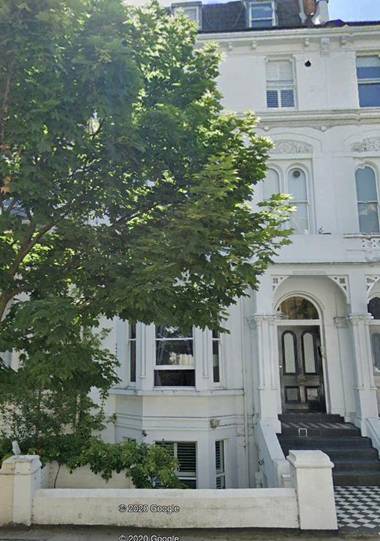
Figure 2.
5 Sinclair Road, Hammersmith, London.
(Photograph courtesy of Google Earth)
The 1891 Census of England shows the Hart family living at 3 Sinclair
Road in Hammersmith. Other members
of the family living at this address at the time included his father and mother,
his sister Nora (10 years old), his brother Henry Rochester (5 years old),[2]
an uncle and several boarders. Apparently
the family moved two doors away from their previous residence because more room
was needed for the family and boarders. Conwayís
mother died in Hastings, Sussex on the 17th of January 1898 when he
was only 14 years old.
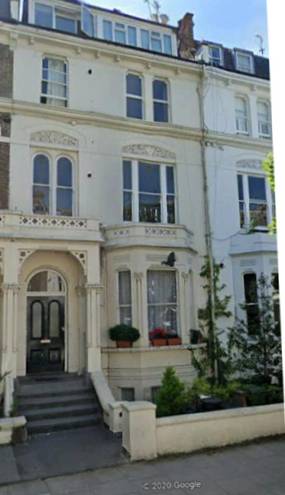
Figure 3.
3 Sinclair Road, Hammersmith, London.
(Photography courtesy of Google Earth)
In 1907 Conway was out on his own and living at 31 Victoria Road in
Lambeth, London. He was living in a
one-room furnished flat on the second floor of the building and was employed as
an Underwriter, probably at his fatherís bank.
The 1911 Census of England shows Conway, aged 27, as a visitor at 25
Pulteney Road in Bath. This was the
household of a widow by the name of Constance Georgina Fielding, (51), her
bachelor son Edward Fleming Fielding (31), a solicitor, and her married daughter
Georgina Maud Bessie Karney (28) along with Georgina Maudís one-year old son
Gilbert Henry Peter Karney. The
household employed three domestic servants.
As shown in Figure 4 below, 25 Pulteney Road was a rather large,
luxurious home. Conway may have been
visiting a friend at this address or perhaps he was engaged in an assignment for
his bank.
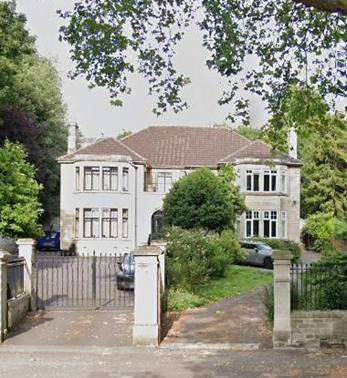
Figure 4.
25 Pulteney Road in Bath.
(Photograph courtesy of Google Earth)
In August of 1914 when the Great War began, Conway John Hart was 30 years
old. Hart applied for and received a
commission as a Temporary 2nd Lieutenant in the 16th
(Service) Battalion of The Sherwood Foresters on the 18th of October
1915,[3]
just after his 32nd birthday and a little over a year and two months
after the Great War started. One
wonders what prompted him to apply for a commission.
Did he feel the need to do his bit for the war effort?
Was he afraid of being called a shirker or a slacker by not serving?
His motivation is not known. It
is also curious that as a Londoner, born and bred, he would seek a commission in
the Nottinghamshire and Derbyshire Regiment.
In any case, he and his battalion were mobilized for war on the 6th
of March 1916 and were immediately sent to France with the 39th
Division of Kitchenerís New Army.
The first action that his battalion took part in occurred on the 30th of June 1916 at Richebourg l'Avouť. This was site of the Battle of the Boar's Head that owes its peculiar name to the shape of a network of trenches forming a salient. This battle aimed to distract the Germans and to make them believe that the Great Offensive would be launched in Richebourg and not in the Somme. Second Lieutenant Hart was wounded at Ferm Du Bois during this battle on the 12th of July 1916. Apparently his wound was not severe as he was back with his battalion in October. He was promoted Lieutenant on the 22nd of August 1916, perhaps during a period of convalescence from his wound.
The next action in which his unit participated was the Battle of Ancre Heights, which began on the 1st of October 1916. This is the name given to the continuation of British attacks after the Battle of Thiepval Ridge from the 26th to the 28th of September during the Battle of the Somme. The battle was conducted from Courcelette near the AlbertĖBapaume road, west to Thiepval on Bazentin Ridge. British possession of the heights would deprive the German 1st Army of observation towards Albert to the southwest and give the British observation north over the Ancre valley to the German positions around Beaumont-Hamel, Serre and Beaucourt.
Many small attacks were made during the battle, amid interruptions caused by frequent heavy rain, which turned the ground and roads into rivers of mud and grounded aircraft. German forces in footholds on the ridge, at the east end of Staufen Riegel (Regina Trench) and in the remaining parts of Schwaben-Feste (Schwaben Redoubt) to the north and Stuff Redoubt (Staufen-Feste) north-east of Thiepval, fought a costly defensive battle with numerous counter-attacks and attacks, which delayed the British capture of the heights for more than a month.
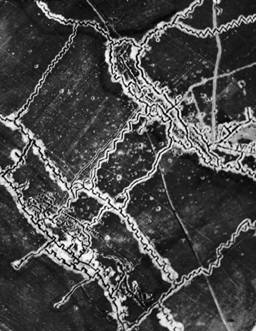
Figure
5. Schwaben Redoubt.
(Schwaben
Redoubt is the network of trenches in the upper right of the photograph)
(Photograph courtesy of Wikipedia)
Lieutenant Hartís final battle took place at the Schwaben
Redoubt, a battle that involved many units and much hard fighting.
The area to the right (east) of Schwaben
Redoubt was attacked by the 53rd Brigade of the 18th (Eastern)
Division during the Battle of Thiepval Ridge during the 26th to 28th
of September. The 8th Suffolks captured Schwabengraben
(Schwaben Trench) in a few minutes and after a ten-minute halt, advanced to Zollern
Trench by 1:15 p.m., meeting troops of the 54th Brigade north of
Thiepval. The advance towards the redoubt was stopped after 250 yards, by
small arms fire from the front and flanks and the troops retired after dark.
Attempts on the left to bomb forward during the evening also failed. The 54th
Brigade was to capture the west end of Thiepval and advance about a half mile to
Schwaben
Redoubt. The battalion on the right captured the east end of Thiepval and the
left hand battalion managed to get halfway through the west end of the village.
A third battalion sent forward as a reinforcement, was severely bombarded by
German artillery as it moved forward and the survivors dug in with the leading
battalions, just ahead of the village on the right; the attack on Schwaben
Redoubt was postponed.
On the 28th of September, the 53rd Brigade formed up for a new
attack on tapes facing northwest from Zollern
Trench, with the left-hand battalion to capture the redoubt. The advance began
at 1:00 p.m. and easily captured Bulgar Trench. The Midway Line held out for
longer but the area east of the redoubt was approached by 2:30 p.m. On the left,
the 7th Queen's advanced on the redoubt, drifted to the left but
managed to get into the southern face of the redoubt and take fifty prisoners.
The battalion also managed to take the southwest corner, then attempted to
attack to the north but was stopped and established a barricade. By 5:00 p.m.,
all of the south face had been captured and the troops were ordered to dig in.
The capture of the south face of Schwaben
Redoubt was observed by the crews of Royal Flying Corps contact patrols and
artillery observation aircraft directed artillery-fire, which destroyed 16 gun
pits, damaged fifteen and destroyed nine ammunition pits. Poor weather
restricted flying on the 29th of September but the next day was
bright and low-flying sorties discovered that most of the Schwaben Redoubt had been captured.
On the 29th of September the British positions in the redoubt
had been consolidated and the 7th Queen's relieved. On the following
day, the 8th East Surrey was counter-attacked and forced out of the
redoubt, until a bayonet attack restored the position, but the west face was
lost by the 7th West Kents. At 4:00 p.m., the East Surreys attacked
the northern face and took the objective but the attack up the west face was
repulsed. A German counter-attack from the west at 9:00 p.m., forced the
defenders of the north face back to the Stuff Trench junction.
The 55th Brigade in the Schwaben
Redoubt, was attacked by at 5:15 a.m. on the 2nd of October.
The German attack gained a small area after a bombing fight had lasted
all day. Both sides resumed bombing on the 4th of October, with no
advantage gained by either side. The following day the 8th Norfolks
tried a converging attack on the rest of the redoubt at 10:00 a.m., through deep
mud which impeded movement and no ground was gained.
The 39th Division took over from the 18th Division
on the 5th of October and there were two relatively quiet days.
Attacks by the Germans on the 117th Brigade of the 39th
Division were made during the 7th and 8th of October. The
German attacks were supported by Flammenwerfer (flame thrower) detachments and were repulsed by two battalions of the
117th Brigade, the 16th and 17th Sherwood Foresters, which
stood their ground.
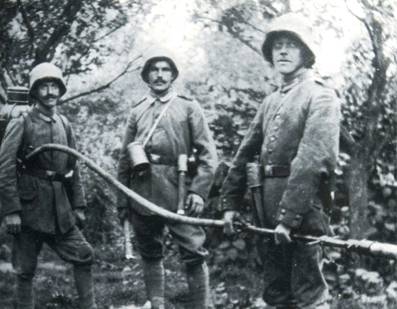
Figure 6.
German Flammenwerfer Troops.
(Photograph from the authorís collection)
The time now came for Lieutenant Hartís battalion to attempt to take
the German positon on Schwaben Redoubt. At
4:30 a.m. on the 10th of October 1916 the 16th Battalion
of The Sherwood Foresters made a surprise attack over open ground on the
northern face beyond the crest of the redoubt.
The attack was made over open ground as the trenches had filled with mud.
Germans were waiting and repulsed the attack with the battalion suffering heavy
losses.[4]
Only the right company reached the trench.
Lieutenant Hart was killed in action during this attack.
Lieutenant Hart was buried at Mill Road Cemetery in Thiepval, France, Plot 17, Row G, Grave 5. He also is commemorated on the Rosslyn Park Football Club Rugby Club War Memorial on Upper Richmond Road, Roehampton, London.
For his service during the war Lieutenant Hart was awarded the British War Medal and Victory Medal. The medals, along with a Memorial Plaque and Scroll (see APPENDIX A) were sent to his father at 24D Victoria Road, Upper Norwood, London S.E. 19.
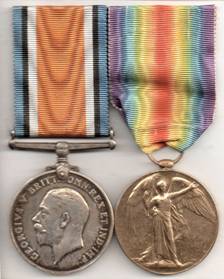
Figure 7.
The British War Medal and Victory Medal.
(This photograph is from the authorís collection, but the medals are not those
awarded to Lieutenant Hart for his service)
During the attack on the Schwaben Redoubt by the 16th
Battalion, three other officers were killed in action.
They were:[5]
ō
Temporary 2nd
Lieutenant Alec Bayzand
of the 19th Battalion, attached to the 16th Battalion.
Commemorated on the THIEPVAL MEMORIAL Pier and Face 10 C, 10 D and 11 A.
ō
2nd
Lieutenant Leslie Wentworth Godwin
of the 3rd Battalion, attached to the 16th Battalion.
His grave is at the CONNAUGHT CEMETERY, THIEPVAL, Plot X, Row L, Grave 1.
ō
2nd
Lieutenant Claude Godfrey Loveday
of the 2nd Battalion, attached to the 16th Battalion.
He was the son of Harry and Dora Loveday, of 11, Colville Gardens,
Notting Hill, London. Loveday was born at Hurstpierpoint, Hassocks, Sussex.
He was 19 years old when he was killed.
His grave is at the GUARDS' CEMETERY, LESBOEUFS VII. L. 4.
There were 57
Non-Commissioned Officers and Other Ranks of the regiment killed in the assault.
Forty-three of the 57 were men of the 16th (Service)
Battalion. The remaining men were
attached to the 16th Battalion for the assault on the Schwaben
Redoubt. The men killed that day
included:
Company
Sergeant Major: 1
Sergeants:
2
Acting Sergeants:
2
Lance Sergeants:
2
Corporals:
3
Lance Corporals:
4
Privates:
43
In addition to the men killed in action on the 10th of
October, one officer (11-10-1916), one Lance Corporal (12-10-1916) and one
Private (13-10-1916) of the 16th Battalion died of wounds on the
dates shown. These men most likely
were wounded during the attack on the Schwaben Redoubt.
The officer was Temporary Lieutenant William Robert Alexander Lehfeldt, the
son of Frederick Charles Lehfeldt (later Leyfield)[6]
and Mary Eliza Lehfeldt of 40, Kensington Hall Gardens, London.
Lieutenant Lehfeldt was 28 years old when he died.
He is buried in the Etaples Military Cemetery, France. Plot 1. Row B. Grave 61.
If the deaths of all those mentioned above were not enough, the story of
the Company Sergeant Major killed in the attack on the Schwaben Redoubt and the
death of his two brothers in the war certainly adds tragedy to this story.
25502 Company Sergeant Major Robert
Lilliman
Robert Lilliman was born at Staveley, Derbyshire. He was the son of Henry and Hannah Lilliman of 143, Blake Street, Mansfield Woodhouse, Nottinghamshire and the husband of Lillian Francis Elizabeth Lilliman, of 53 Sherwood Street, Mansfield Woodhouse. He was a coal miner at Langwith Colliery, Derbyshire prior to enlisting at Mansfield on the 21st of April 1915. He was appointed Lance Corporal on the 17th of May 1915, promoted to Corporal on the 2nd of June 1915, to Sergeant on the 25th of June 1915 and to Colour Sergeant Major on the 24th of August 1916. He went to France on the 6th of March 1916 and was killed in action on the 10th of October 1916 in the attack on Schwaben Redoubt, Thiepval, France during the Battle of the Somme while serving as the Company Sergeant Major of one of the companies of the 16th (Service) Battalion. He is commemorated on the Thiepval Memorial, France. Pier and Face 10 C, 10 D and 11 A along with 2nd Lieutenant Alec Bayzand. He was the last of three brothers to die in the war.
His brothers Private Joseph Lilliman, 9th Battalion Sherwood Foresters (Notts & Derby) Regiment and Private William Henry Lilliman, 2nd Battalion Sherwood Foresters (Notts & Derby) Regiment also fell in the Great War.
12833 Private Joseph Lilliman
Private Joseph Lilliman served in the 9th Battalion Sherwood Foresters (Notts & Derby) Regiment. He was born at Staveley, Derbyshire, the son of Henry and Hannah of 143, Blake Street, Mansfield Woodhouse, Nottinghamshire and was the husband of Alice Lilliman, Newcastle Street, Mansfield. He enlisted at Mansfield and landed at Gallipoli on the 7th of August 1915. He was killed in action on the 9th of August 1915 during the attack at Ismail Oglu Tepe (Chocolate Hill), Gallipoli, Turkey. He is commemorated on the Helles Memorial, Turkey. Panel 150 to 152. He was the first of the Lilliman brothers to die.
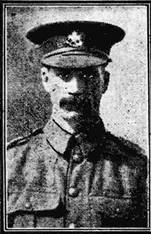
Figure
8. 12833 Private Joseph Lilliman, 9th
Battalion, The Sherwood Foresters.
(Photograph courtesy of www.the-sherwood-foresters.co.uk)
22248 Private
William Henry Lilliman
Private William Henry Lilliman served in the 2nd Battalion of The Sherwood Foresters (Notts & Derby) Regiment. He was born at Staveley, Derbyshire, the son of Henry and Hannah of 143, Blake Street, Mansfield Woodhouse, Nottinghamshire and was the husband of Florence Lilliman, of 145 Blake Street, Mansfield Woodhouse. He was a coal miner prior to enlisting at Mansfield. He went to France on the 20th of July 1915 and was killed in action on the 5th of October 1915, by German shellfire, prior to their attack on the trenches at Oder Houses, Potijze, Belgium. He is buried in Potijze Burial Ground Cemetery, Belgium. Row D1. Grave 6. He was the second of the Lilliman brothers to die.
EPILOGUE
So how did an historian who specializes in the history of the Royal Engineers get involved with a study of men in The Sherwood Foresters? It came about through a study of the life and military service of a Sapper officer by the name of Major Robert Cecil Lord, MC, R.E. I started work on Major Lordís story back in 1979. While doing that work I found that Major Lord had left a pair of gold cuff links in his will to a Mrs. Barbara Harris of Upper Norwood, London, S.E. Lordís will provided Mrs. Harris address so I wrote to her and received a reply from a friend of Mrs. Harris. Her friend indicated that Mrs. Harris was ill and could not help me directly with my request for information but that she, Mrs. Munzer, would do her best to answer my questions and attempt to find a photograph of Major Lord. Mrs. Munzer contacted me and told me that she had looked through many letters written to Mrs. Harris during the First World War but found none from Major Lord. She found only one photograph of a man in uniform and she sent it to me telling me that she could not identify the officer in the photo. She did tell me that she had read many letters in Mrs. Harrisí collection that were written on the letterhead stationery of the ď16th Battalion, The Sherwood Foresters (Notts and Derby) Regiment.Ē These letters were all signed ďConway.Ē Since by his cap badge the officer in the photograph obviously had served in The Sherwood Foresters and since the letters had been written on letterhead stationery of that regiment, it was not a leap to conclude that the officerís name was Conway. Except I thought it was his last name! I searched numerous Army Lists for an officer named Conway in The Sherwood Foresters, all to no avail. It was not until I came upon the web site www.the-sherwood-foresters.co.uk that I found the identical photograph identified as Lieutenant Conway John Hart. So although the photograph had been acquired about 1980, it was not until 2020 that I was able to identify it due to the greater amount of information now available on the internet.
As I studied the Lieutenant Hartís story I came across the story of Company Sergeant Major Lilliman and his two brothers, all killed in action in the Great War. Truly this is a tragic story, but one that was repeated many times in England, Scotland, Wales and Ireland during that most devastating war.
APPENDIX A.
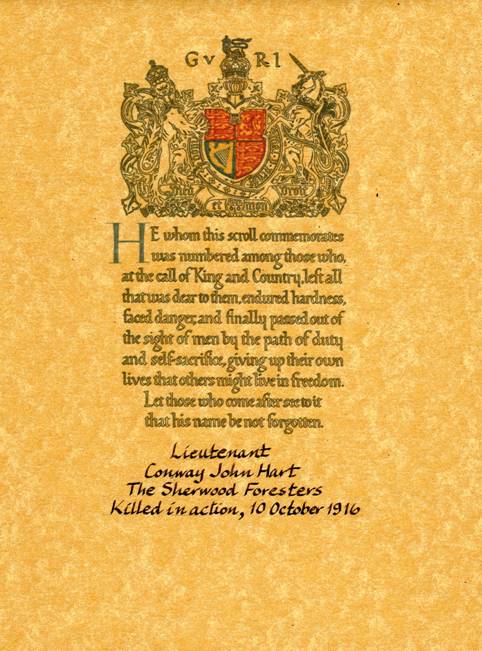
Figure
9. Facsimile of Lieutenant Hartís
Memorial Scroll.
(Printed by the author using the Officers Died in the Great War CD-ROM)
REFERENCES
Census
Computer
Software
Officers
and Soldiers Died in the Great War.
Naval and Military Press, Uckfield, U.K.
Documents
Family Tree
Hart
Family Tree (Ancestry.com)
Internet Web
Site
http://www.godalmingmuseum.org.uk/index.php?page=adrian-harding
www.the-sherwood-foresters.co.uk
London
Gazette
The
London Gazette, 5 November 1915, p. 10919.
Medal Rolls
and Index Cards
Medal Index Card, Lieutenant Conway John Hart, Notts and Derby Regiment.
ENDNOTES
[1] This studio photograph was taken by Adrian Harding in Godalming, Surrey. Adrian Francis Harding (1882-1968) was a well-known photographer in Godalming from c.1910-1939. See the Godalming Museum web site link.
[2] No evidence has been found to indicate that Henry Rochester Hart served in the Great War of 1914-1918.
[3] The London Gazette, 5 November 1915.
[4] Miles, W. (1992) [1938]. Military Operations, France and Belgium, 1916: 2nd July 1916 to the End of the Battles of the Somme. History of the Great War Based on Official Documents by Direction of the Historical Section of the Committee of Imperial Defence. II (facs. Repr. Imperial War Museum and Battery Press ed.). London: HMSO. ISBN 978-0-901627-76-6.
[5] Commonwealth War Graves Commission.
[6] It would appear that the Lehfeldts changed their Germanic name to Leyfield to avoid possible antagonism on the part of many in England during the Great War and during the period following the war. It would be most unfortunate if they were subjected to any such treatment after giving their son for King and Country.